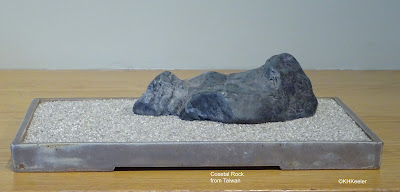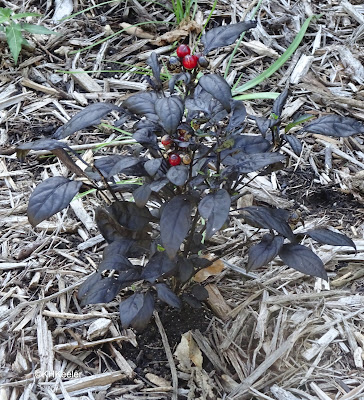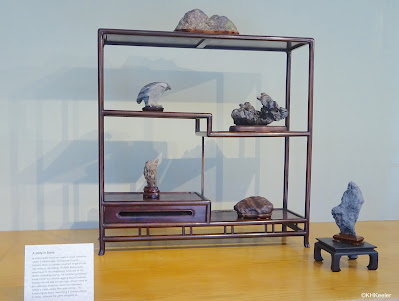In October we visited Washington D.C. I remember my first visit in 1969. I was a college graduate form Ohio. I had seen New York City, a bit of Boston, and Cleveland. Wow, Washington! The nation's capital, built to be a showplace. I was very impressed. Since then I have been to Washington's museums many times. This was my first visit to the National Arboretum. It is about 3 miles from the Mall; we took Uber.
 |
| By main building, National Arboretum |
Created in 1927, the Arboretum is managed by the U.S. Department of Agriculture' Agricultural Research Service. Its mission is research improving ornamental and landscape plants and promotion through public gardens and exhibits. It has 450 acres and 9.5 miles of paths. It felt much like a very large city park; many of the visitors were strolling with babies in baby carriages or out for a run.
We didn't walk anything like all the paths, but spent a very pleasant September afternoon wandering around. They had mature iconic species, for example this dawn redwood (
Metasequoia glyptostroboides, bald cypress family, Cupressaceae):
 |
| dawn redwood, Metasequoia glyptostroboides |
I particularly noticed plants where I knew the name better than the plant. This is a flowering quince from Japan, genus
Chaenomeles, probably
C. japonica. Quinces are
fruits with a long history that are not grown much today. Of course, this plant was nearly leafless because it was fall, but I still got a look at the plant shape and a few leaves. If you google it, you'll see that it has handsome flowers.
 |
| Japanese quince, Chaenomeles japonica |
The National Bonsai and Penjing Museum was near the main building. We enjoyed it (previous blog:
link).
 |
| National Bonsai and Penjing Museum |
 |
bonsai, National Bonsai and Penjing Museum
|
The National Bonsai and Penjing Museum had a substantial collection of rocks. Arranging interesting rocks as pieces of art is a very old tradition in China, Japan, and Korea (at least). I have seen some wonderful ones in Asia. The Japanese term is
suiseki, for the Chinese they are
gongshi or scholar's rocks
, and in Korean
suosek. The custom of stone appreciation--collecting and displaying naturally shaped stones and rocks--goes back several thousand years. Wikipedia says there are stone appreciation clubs all over the world except North America. However, I remember a card saying that a stone viewing club had donated these stones to the National Bonsai and Penjing Museum and a quick Google search finds stone viewing or suiseki or similarly named clubs both on the Atlantic Coast and in the Pacific Northwest, so North America is not totally lacking in stone appreciation.
 |
Another stone displayed for apprediation
|
On this trip, one of the plants I was looking for was boxwood, Buxus. I was trying to learn to recognize the plant. It is very common, if I had the id. right. The National Arboretum has a National Boxwood Collection but when I arrived, I discovered the collection was closed. Closed? You can close a planting? But of course you can, you just put do-not-cross tape around it. I may have come in from the wrong side, but I only saw that it was closed, no explanation. However, the explanation is on the National Arboretum website: boxwood blight. This blight, like many introduced plant diseases, causes a high frequency of plant death. There are a lot of boxwoods in the U.S., the spread of boxwood blight is a real worry. So the National Arboretum closed the National Boxwood Collection to treat their trees and reduce the spread of boxwood blight. I peered at them from beyond the barrier.
 |
| a beautiful big old boxwood (from as close as I could get). |
The National Arboretum had a display on the nightshade family Solanaceae which inspired my blog on the subject (
link). Here is one I can't name:
 |
| plant in the nightshade family, Solanaceae |
and a famous member of the family, a petunia (genus
Petunia)
They had lots of pepper, tomato and eggplant plants but, it being September, they looked pretty shabby.
Close by was an extensive herb garden. I mostly photographed plants I wanted to learn. This is chaste tree, Vitus agnus-castus (mint family, Lamiaceae). From around the Mediterranean, the chaste tree has a long history in European herbal medicine but I didn't know what it looked like. Now I do.
 |
| chaste tree, Vitus agnus-castus |
Likewise, the sweet grasses (Anthoxanthum and Hierochloe species) are very famous grasses, beloved for their vanilla-like smell and medicinal properties. For many Native Americans they are sacred plants. There are about eight species, native and introduced, widespread in North America, but they grow in wet areas, toward the coasts and north of me, so I don't know them. This one wasn't flowering, so I'll look for sweet grass in the future, but I now have an idea what the leaves are like.
 |
| sweet grass, Anthoxanthum nitens |
We sat in the Friendship Garden, checked out all the plants in the dye garden, viewed plantings recommended for watersheds, circled the water garden...and there was so much more to see...next time.
Comments and corrections welcome
Kathy Keeler, A Wandering Botanist













No comments:
Post a Comment